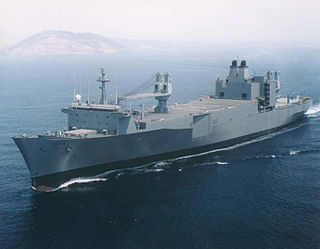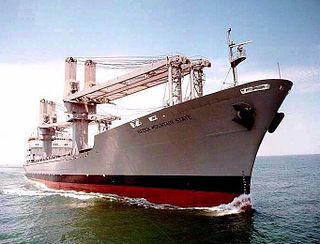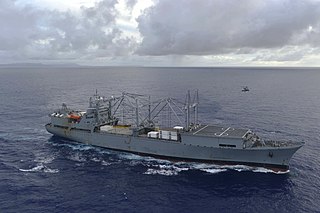
SS Gopher State (T-ACS-4) is a crane ship in ready reserve for the United States Navy. The ship was named for the state of Minnesota, which is also known as the Gopher State.

The Gopher State-class crane ships of the United States Navy are a class of auxiliary vessels. The lead ship of the class is named in honor of the state of Minnesota. Original United States Maritime Administration (MARAD) designation for the ship is C5-S-73b.

SS Cornhusker State (T-ACS-6) is a crane ship in ready reserve for the United States Navy. She is stationed in Newport News, Virginia under operation control of the Military Sealift Command (MSC). The ship was named for the state of Nebraska, which is also known as the Cornhusker State.

An Auxiliary Crane Ship is a vessel of the United States Military Sealift Command designed to operate where port facilities are limited or damaged to transfer cargo between themselves, other vessels, and piers.

USNS Sea Lift (T-LSV-9) was a roll on/roll off (Ro/Ro) cargo ship built for the United States Navy's Military Sea Transportation Service (MSTS), currently the Military Sealift Command (MSC). She became the first ship of Ro/Ro-type to deliver cargo to Vietnam during the war in Indochina.

SS Altair is an Algol class vehicle cargo ship that is currently maintained by the United States Maritime Administration as part of the Military Sealift Command's Ready Reserve Force (RRF). She was built as a high speed container ship by Rheinstahl Nordseewerke in Emden, West Germany, hull no. 431, for Sea-Land Service, Inc. and named SS Sea-Land Finance, USCG ON 550722, IMO 7315571. Due to her high operating cost, she was sold to the United States Navy on 5 January 1982 as USNS Altair (T-AK-291).

SS Regulus is an Algol class vehicle cargo ship that is currently maintained by the United States Maritime Administration as part of the Military Sealift Command's Ready Reserve Force (RRF). She was built as a high speed container ship by A.G. Weser in Bremen, West Germany, hull no. 1383, for Sea-Land Service, Inc. and named SS Sea-Land Commerce, USCG 545200, IMO 7302897. Due to her high operating cost, she was sold to the United States Navy on 27 October 1981 as USNS Regulus (T-AK-292).

SS Grand Canyon State (T-ACS-3) is a crane ship in ready reserve for the United States Navy. The ship was named for the state of Arizona, which is also known as the Grand Canyon State.

SS Keystone State (T-ACS-1) is a crane ship in ready reserve for the United States Navy. The ship was named for the state of Pennsylvania, which is also known as the Keystone State.

SS Gem State (T-ACS-2) is a crane ship in Ready Reserve for the United States Navy. The ship was named for the state of Idaho, which is also known as the Gem State.

SS Equality State (T-ACS-8) was a crane ship of the United States Navy. The ship was named for the state of Wyoming, which is also known as the Equality State. She was scrapped in June 2019.

SS Diamond State (T-ACS-7) is a crane ship in the National Defense Reserve Fleet (NRDF) for the United States Navy. The ship was named for the state of Delaware, which is also known as the "Diamond State". The ship was initially a bulk freighter named SS Japan Mail when launched in 1961 and entered service in 1962 with the American Mail Line. In 1971, the ship was lengthened and renamed SS President Truman. In 1987, the vessel was taken over by MARAD and converted to a crane ship and in 1989, renamed Diamond State.

SS Green Mountain State (T-ACS-9) is a crane ship in ready reserve for the United States Navy. The ship was named for the state of Vermont, which is also known as the Green Mountain State.

SS Beaver State (T-ACS-10) is a crane ship in ready reserve for the United States Navy. The ship was named for the state of Oregon, which is also known as the Beaver State.

The Keystone State-class crane ships are seven auxiliary crane ships of the U.S. Maritime Administration Ready Reserve Force. The ships can be quickly activated to support military sea transportation needs. These self-sustaining ships are useful in ports that have limited, damaged or undeveloped port facilities. When activated, they come under operational control of Military Sealift Command.
The Type C7 ship(Lancer Class) is a United States Maritime Administration (MARAD) designation for a cargo ship and the first US purpose-built container ship. The vessels were constructed in US shipyards and entered service starting in 1968. As US-built ships they were Jones Act qualified for shipments between US domestic ports. Under the Jones Act, domestic US maritime trade is restricted to US-built and flagged vessels of US owners and manned by predominantly US-citizen crews. The last active Lancer container-configured ship was scrapped in 2019. Lancers of the vehicle Roll-on/Roll-off (RO/RO) configuration remain held in the Ready Reserve Force, National Defense Reserve Fleet and the US Navy Military Sealift Command. All are steam powered.

For MV Cape Texas, a World War II Type C1-A, see Type C1 ships

MV Cape Taylor (T-AKR-113) is a roll-on/roll-off (RO/RO) ship with the Ready Reserve Force (RRF) of the United States Department of Transportation's Maritime Administration (MARAD). As of 31 December 2014, her homeport is the Port of Houston in Houston, Texas, and she is on ROS-5 status; she is able to be fully operational within 5 days of being activated. When activated, she becomes part of the United States Navy's Military Sealift Command (MSC).

MV Cape Trinity (T-AKR-9711) is a Roll-on/Roll-off (RO/RO) ship with the Ready Reserve Force (RRF) of the United States Department of Transportation's Maritime Administration (MARAD). As of 31 December 2014, the homeport of this motor vessel (MV) is the Port of Houston in Houston, Texas, and she is on ROS-5 status; she is able to be fully operational within 5 days of being activated. When activated, she becomes part of the United States Navy's Military Sealift Command (MSC).

The Type C5 ship is a United States Maritime Administration (MARAD) designation for World War II breakbulk cargo and later a container ship for containerization shipments. The first type C5-class ship was a class of ships constructed and produced in the United States during World War II. The World War II C5-class ship was dry bulk cargo ship built by Bethlehem Steel in Sparrows Point, Maryland. Bethlehem Steel built eight ships in this bulk cargo class and four orders were canceled. The C5-class ship has a 24,250 DWT and was 560 feet (170 m) long. The C5 was mainly used as iron ore carriers. The C5 was needed to replace other ships that sank during World War II. First in her class was SS Venore, USMC #1982, delivered on 20 July 1945. The Type C5-class ship designed to fill the need to move iron ore from Santa Cruz, Chile, to Sparrows Point, Maryland, through the Panama Canal, a round-trip of 8,700 nautical miles . Post World War II, four ships were given C5 class type C5-S-78a, these were roll-on/roll-off container ship built by Ingalls Shipbuilding, Inc. of Pascagoula, Mississippi and operated by the Moore-McCormack Lines. The C5-S-78a had a deadweight tonnage of 16,000 tons.
















